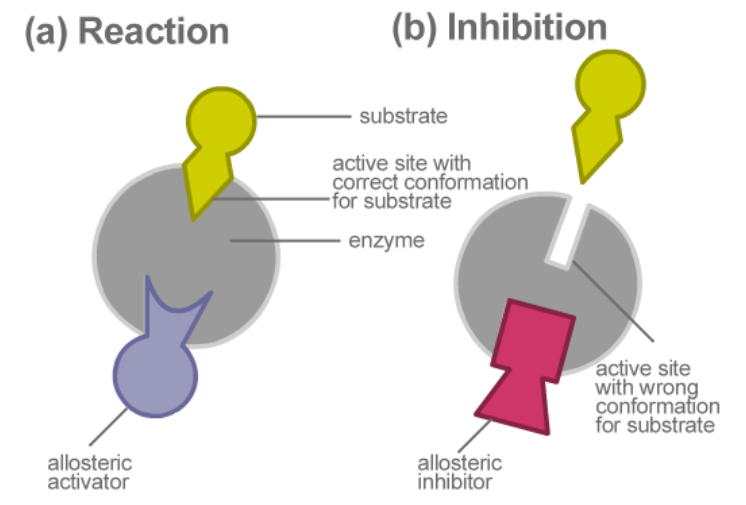
Why is allosteric inhibition called feedback inhibition? Explain.
Answer
471.3k+ views
Hint: Enzyme or protein is known to possess catalytic site as well as the allosteric site. Allosteric site is the site other than the active/catalytic site of enzyme, where, when a molecule binds, it changes the conformation of enzyme which leads to either more or less product formation.
Complete answer:
Allosteric inhibition is called feedback inhibition because in feedback inhibition, the end products of a reaction are known to bind to the allosteric site of the enzyme leading to the inactivation of enzyme thereby producing a lesser amount of products. Thus, feedback inhibition is usually accomplished through an “allosteric site”. The result of feedback inhibition is that it is responsible for adjusting the rate of reaction which depends on how much of the end product is required and thus helping to prevent the accumulation of end products to undesired or dangerous levels. Therefore, allosteric inhibition is called feedback inhibition.

Additional information:
One of the typical examples of feedback inhibition is the inhibition of enzyme hexokinase (playing a role in glycolysis) by glucose-6-phosphate molecules. The enzyme hexokinase is known for the conversion of glucose to glucose-6-phosphate, but, as the reaction moves forward, there is accumulation of glucose-6-phosphate that binds to the allosteric site of hexokinase, thereby inhibiting the conversion of glucose to glucose-6-phosphate.
Note: Feedback inhibition is known for the binding of end products of reaction to the allosteric site of enzyme thereby retarding the enzyme’s activity which will result in low or no new end products. This will help in adjusting the rate of reaction in order to maintain the level of product formation.
Complete answer:
Allosteric inhibition is called feedback inhibition because in feedback inhibition, the end products of a reaction are known to bind to the allosteric site of the enzyme leading to the inactivation of enzyme thereby producing a lesser amount of products. Thus, feedback inhibition is usually accomplished through an “allosteric site”. The result of feedback inhibition is that it is responsible for adjusting the rate of reaction which depends on how much of the end product is required and thus helping to prevent the accumulation of end products to undesired or dangerous levels. Therefore, allosteric inhibition is called feedback inhibition.

Additional information:
One of the typical examples of feedback inhibition is the inhibition of enzyme hexokinase (playing a role in glycolysis) by glucose-6-phosphate molecules. The enzyme hexokinase is known for the conversion of glucose to glucose-6-phosphate, but, as the reaction moves forward, there is accumulation of glucose-6-phosphate that binds to the allosteric site of hexokinase, thereby inhibiting the conversion of glucose to glucose-6-phosphate.
Note: Feedback inhibition is known for the binding of end products of reaction to the allosteric site of enzyme thereby retarding the enzyme’s activity which will result in low or no new end products. This will help in adjusting the rate of reaction in order to maintain the level of product formation.
Recently Updated Pages
What is the importance of Meiosis class 11 biology CBSE

What is a real life example of the second law of t class 11 chemistry CBSE

Is Friction Independent of actual Area of Contact class 11 physics CBSE

The phenomenon of polymorphism presence of two distinct class 11 biology CBSE

The potential energy U in joule of a particle of mass class 11 physics CBSE

A body of mass 5kg falls from a height of 30m If all class 11 physics CBSE

Trending doubts
10 examples of friction in our daily life

The correct order of melting point of 14th group elements class 11 chemistry CBSE

Difference Between Prokaryotic Cells and Eukaryotic Cells

One Metric ton is equal to kg A 10000 B 1000 C 100 class 11 physics CBSE

What is the specific heat capacity of ice water and class 11 physics CBSE

State and prove Bernoullis theorem class 11 physics CBSE




